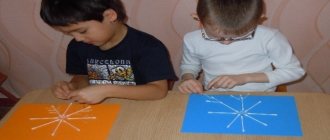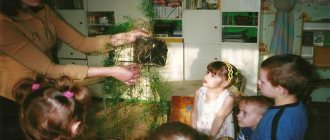In 2021, scientists from England and Portugal found that the first fairy tale in history was composed 6 thousand years ago. It was called “The Blacksmith and the Devil” and talked about a blacksmith who made a deal with the devil and received the ability to connect any materials. Subsequently, different peoples of the world composed thousands of fairy tales, which today parents read to their children before bed. But have you ever thought about why children need fairy tales? It is believed that thanks to such stories, children more easily understand the difference between good and evil, and also prepare for various life situations. And this is the honest truth - fairy tales play an important role in raising a child. But recently, scientists conducted an experiment and found that fairy tales can also influence the emotional state of children and help them cope with stress more easily.
Scientists have proven that reading fairy tales is beneficial for children
Article on the topic “The meaning of fairy tales in a child’s life.” article on the topic
Article on the topic: “The meaning of fairy tales in a child’s life.”
A fairy tale is a magical and fascinating world that attracts children with amazing adventures, transformations and heroes. These are the first literary works that every child touches during preschool childhood. A fairy tale enters a child’s life from a very early age, accompanies him throughout preschool childhood and remains with him for life. His acquaintance with the world of literature, with the world of human relationships and with the entire surrounding world in general begins with a fairy tale. The role of fairy tales in raising children is great. Firstly, they develop imagination and encourage fantasy. They also develop correct speech and learn to distinguish between good and evil.
By telling a child a fairy tale, we develop his inner world. And the sooner we read books, the sooner he will begin to speak and express himself correctly. A fairy tale forms the basis of behavior and communication. Develops imagination and creativity.
Every person has their own first and favorite fairy tale. A fairy tale that we carry in our hearts throughout our lives. And it’s different for everyone. And why? What is the deeper meaning here?
In every fairy tale we read, we can find a complete list of human problems, as well as ways and means of solving them. The subconscious choice of a fairy tale reflects the problems of personal moments in a person’s life, their aspirations and beliefs. The famous American psychologist Eric Berne argued back in the mid-twentieth century that with the help of fairy tales it is even possible to program a child’s future.
Fairy tales are not as simple as they seem at first glance - they are like a multi-layered cake. In childhood, we see the first layer, it is the most understandable, and with age, the deeper meaning of the embedded plan in the fairy tale is revealed to us. And the shorter the fairy tale, the greater the volume of information embedded in it. And in this case, parents need fairy tales no less than their children.
As an example, I propose to analyze the fairy tale “Kolobok”. Everyone, you remember well how the bun runs away from home to see the world. Of course, he has a great sense of adventure. According to characterological characteristics, he is energetic, sociable, quite active, agile, lively, has a good character and a boundless desire to learn something interesting and unknown. Temperament type - rather sanguine.
On his way to unknown adventures, he meets several characters who become a hindrance to him. But Kolobok knows how to negotiate with everyone - he was able to convince even the most negative hero from a fairy tale to let him go. Over time, already confident in himself as a mature personality, the traveler loses his vigilance, his self-confidence and insolence suppresses such psychological processes as attentiveness and observation - and, with the help of deception, he is eaten by the Fox.
This fairy tale plot is found in fairy tales of many peoples of the world. It is instructive because it carries the wisdom of the people, which is passed down through generations from ancestors to future descendants.
What lessons can be learned from this fairy tale and what can a child be taught by telling it:
1) Do not lose your sense of self-control. You can always find a way out of the situation and confront the one who insults you: call your friends for help, show cunning. After all, Kolobok could have been eaten by the Hare if our hero had not cheated: “Come on, I’ll sing you a song!” Or, just run away - that’s what Kolobok did every time, singing a song.
2) Do not trust the first person you meet. In life you meet different people, both friendly and vice versa. Just in case, you always need to be ready for anything, because bad people do not always directly and openly make it clear: “I will eat you!” Most, in relation to you, can act like the cunning Fox, lulling your vigilance with flattery and skillfully played kindness; Therefore, you should be very careful here to guess people's intentions.
3) Choose the right path in life. You should talk about this with your child at the very end. After all, Kolobok was baked for a corresponding purpose, Grandfather and Grandmother pinned their hopes on it, and our naughty hero ruined the lives of both himself and them. Each person has his own abilities, this is a sign of the purpose of everyone in this world. According to these signs and the vocation of the soul, people, as a rule, try to choose a profession, type of activity, occupation. And, of course, having made the right choice of profession, a person will be able to realize his talents in life, and with his successes, bring great benefit to himself, his family and society, and also receive pleasure from his professional activities. Self-assertion.
As a result:
- Don’t rush to refuse. When you are asked to “scrape the bottom of the barrel,” and you know that there is nothing there, scratch it anyway. Grandmother had enough flour for Kolobok...
— Do not leave children unattended. After all, Kolobok is none other than a baby who, as soon as Grandma turned away, jumped off the windowsill and went into the forest!
- Don't forget about your childhood. Why did the main character of the fairy tale decide to go on an adventure so recklessly? Probably because he felt rather sad lying on the windowsill alone. Therefore, you should not rush to scold your child for disobedience, but rather remember how you yourself once in childhood wanted to feel “adult and independent,” saying, at the mother’s request to help: “I myself!”
Recommendations:
* Do not try to replace reading a fairy tale with watching cartoons. Even when you're busy, find time to read with your family or before bed. 15 minutes a day is not enough for a lively, emotional display of a fairy tale by you for your child, but it is very important for its psychological development. Cartoons are fun to watch, but they don't develop imagination because the action is presented on the screen. If you want your child to develop creatively, you need to provide him with room for imagination.
A fairy tale can not only educate, but also correct behavior, and in many cases relieve complex psychological problems and stress that trouble a child’s fragile psyche. To do this, you can choose suitable plots from existing fairy tales and analyze them in role-playing games or theatrical productions. An excellent correctional moment would be the game “Think of it differently,” in which the child is asked to create a new ending to his favorite fairy tale. Pay attention to what plot moves the child chooses, whether he strives to make the ending of the story happy, and what characters he associates with himself and his loved ones. Particular attention should be paid if the child consistently gives preference to unhappy endings and pays increased attention to negative characters.
But the most important moral is what is evil and what is good. This is exactly what is expressed in our fairy tales. As a result, the child compares himself with a good character and knows that evil is punishable.
*It is best to read a story before bed, when the child is calm, in a good mood and ready to listen carefully. You need to read it emotionally. At the end, you can discuss the fairy tale: what you liked and what you didn’t. Ask your child to describe the characters.
A fairy tale can relieve a child’s anxiety. You can also put on an emotional speech, make it beautiful and figurative. The vocabulary is expanding, the dialogue is being built correctly, and coherent logical speech is developing.
Tell the story in an interesting way, as if feeling that this is a different world. Read with good diction and intonation, then the child will learn to pronounce sounds clearly.
* Before reading an unfamiliar fairy tale to your son or daughter, quickly skim through it. In modern interpretations you can find, for example: “... and tore him into a thousand small pieces.” This is too much. Therefore, in this case, you can replace this fairy tale with another, or replace some of the actions of the main characters with softer ones that do not reflect manifestations of aggression and various negativism, because the child may form the opinion that only evil and cruelty can be strong and reasonable.
* You should not read sad bedtime stories to your child. Because it will be hard to imagine what a child might dream about after such a fairy tale.
- Children should know and understand that in life there is, in addition to the “external”, an “internal” side (the main educational meaning of the fairy tale). Talk about this with your child, choosing the moment subtly and carefully. Purely for educational purposes, raising the child to what the right thing to do in such situations. And even better, if the child has recently done something wrong, then choose an appropriate fairy tale according to this situation, highlighting the instructive and educational moment.
Fairy Tales: Education with Heart and Mind
To ensure that values education goes beyond good intentions, it must be concrete, practical and realistic. Fairy tales work well for this because children can use fairy tale characters to trace the consequences of certain behaviors.
Many of the classic fairy tales may seem too “correct” to adults: the kind-hearted and hard-working girl is necessarily beautiful and can marry the prince in the end, the lazy stepsister is ugly and is eventually punished. People know from life experience that the world is often more complex. However, children are just beginning to understand certain connections. Often the black and white world of fairy tales helps them navigate.
Fairy tales are food for the soul of everyone, young and old. With legends and stories we find ourselves in a land of dreams, fantasies, limitless possibilities and miracles. The understanding of good and bad, as well as awareness of life values, is heightened. Many children and adults love the life-affirming, beneficial, creative and healing power contained in fairy tales. The stories teach a lesson that is always the same, regardless of the place and time in which they were written: it is worth helping others and standing up for justice.
Moral aspect
A fairy tale is an integral element of moral education. It is based on the perception of such basic philosophical concepts as good and evil. The language of a fairy tale is accessible to a child and makes it easy to explain to him the difference between good and bad.
The relationships between characters and the plot help to understand the reasons for an action and its consequences. The fairy tale shows a direct relationship between a person’s moral qualities and the specific life situations in which he finds himself. It teaches the most valuable quality - the ability to empathize and understand another person.
The tale forms the foundations of correct behavior and communication skills, that is, it has the most important social significance.
For the formation of a child’s moral values, the comments that parents give while reading together are very important. An equally important educational moment is the obligatory victory of good over evil. Good heroes are always hardworking, brave, beautiful, savvy, and honest. By identifying himself with them, the child adopts high moral qualities, learns to find the right solutions, and think positively.
Fairy tales help to see psychological problems in time
The educational significance of fairy tales is also manifested in the fact that they are able to influence the formation of personal qualities. In childhood, the psyche is still unstable, the border between good and evil is slightly blurred. Therefore, parents need to listen to their children and their fabulous preferences.
It is possible that the characters the child loves and dislikes indicate the child’s emerging emotional problems. In this case, with the help of the same fairy tale, it is quite possible to slightly correct the development of the child’s psyche and direct it in a peaceful direction. It is very important to discuss together what you read, draw the child’s attention to some key points, and explain what is not clear.
Developmental aspect
A fairytale work develops the most important communication and intellectual skills in children:
- imaginative thinking; active speech; attention; the ability to coherently express a thought; creativity and imagination; all types of memory; the ability to correctly use facial expressions.
The characters' remarks train the articulatory apparatus and enrich the vocabulary.
The culture of speech develops, the skill of correct pronunciation of rarely used words is formed. If the fairy tale is a Russian folk tale, then the child’s speech organically includes proverbs and sayings. Thus, thanks to folklore, the child is drawn into the space of folk culture.
Numerous options for using literary material give the baby the opportunity to fully realize their potential. Expressive reading, theatrical performance, puppet or finger theater, drawing - you can play out the plot in different ways. The child feels joy, creative freedom, elation, becoming an inhabitant of a fairy-tale world.
Photo: fairy tale “The Ryaba Hen”
It is important to know:
- The role of play in raising a preschool child
Bible stories
For children to succeed in the world, it is important that they can build on a moral foundation. In addition to parents, kindergartens and schools have the task of laying these building blocks. In this context, holistic education is of central importance. It involves more than math, writing, or reading skills. Since Russia is a country with strong religious roots, biblical stories are part of it. They contain wisdom that is still relevant today. Therefore, it is good when children, even in atheistically minded families, are told simple parables.
Everyday Stories
Writing fairy tales for children is quite normal. If you go through life with your eyes open, you can save time searching for stories. Because stories are lying around, you just need to pick them up.
It is important for children that their parents and grandparents tell them everyday stories from their own lives. The quality of screw time plays an important role here. Children rejoice when they hear:
– When grandfather married grandmother...
– Once we celebrated the New Year in a funny way...
– Do you remember we went to the zoo...
– When a mouse was running around the living room...
Sharing stories about small family events develops social awareness and a sense of togetherness.
However, storytelling is not a one-way street from adult to child. Sometimes the plot moves back and forth, like a spontaneous conversation. Then the story can take a completely unexpected, imaginative or even fantastic turn. These shared everyday stories are especially interesting! Of course, you also need to let children tell their own stories. Enjoy listening without taking any corrective action.





